Copyright
Preface
Chapter 1: Models for Integrated-Circuit Active Devices
Introduction
Depletion Region of a pn Junction
Depletion-Region Capacitance
Junction Breakdown
Large-Signal Behavior of Bipolar Transistors
Large-Signal Models in the Forward-Active Region
Effects of Collector Voltage on Large-Signal Characteristics in the Forward-Active Region
Saturation and Inverse-Active Regions
Transistor Breakdown Voltages
Dependence of Transistor Current Gain βF on Operating Conditions
Small-Signal Models of Bipolar Transistors
Transconductance
Base-Charging Capacitance
Input Resistance
Output Resistance
Basic Small-Signal Model of the Bipolar Transistor
Collector-Base Resistance
Parasitic Elements in the Small-Signal Model
Specification of Transistor Frequency Response
Large-Signal Behavior of Metal-Oxide-Semiconductor Field-Effect Transistors
Transfer Characteristics of MOS Devices
Comparison of Operating Regions of Bipolar and MOS Transistors
Decomposition of Gate-Source Voltage
Threshold Temperature Dependence
MOS Device Voltage Limitations
Small-Signal Models of MOS Transistors
Transconductance
Intrinsic Gate-Source and Gate-Drain Capacitance
Input Resistance
Output Resistance
Basic Small-Signal Model of the MOS Transistor
Body Transconductance
Parasitic Elements in the Small-Signal Model
MOS Transistor Frequency Response
Short-Channel Effects in MOS Transistors
Velocity Saturation from the Horizontal Field
Transconductance and Transition Frequency
Mobility Degradation from the Vertical Field
Weak Inversion in MOS Transistors
Drain Current in Weak Inversion
Transconductance and Transition Frequency in Weak Inversion
Substrate Current Flow in MOS Transistors
Summary of Active-Device Parameters
Chapter 2: Bipolar, MOS, and BiCMOS Integrated-Circuit Technology
Introduction
Basic Processes in Integrated-Circuit Fabrication
Electrical Resistivity of Silicon
Solid-State Diffusion
Electrical Properties of Diffused Layers
Photolithography
Epitaxial Growth
Ion Implantation
Local Oxidation
Polysilicon Deposition
High-Voltage Bipolar Integrated-Circuit Fabrication
Advanced Bipolar Integrated-Circuit Fabrication
Active Devices in Bipolar Analog Integrated Circuits
Integrated-Circuit npn Transistors
Integrated-Circuit pnp Transistors
Passive Components in Bipolar Integrated Circuits
Diffused Resistors
Epitaxial and Epitaxial Pinch Resistors
Integrated-Circuit Capacitors
Zener Diodes
Junction Diodes
Modifications to the Basic Bipolar Process
Dielectric Isolation
Compatible Processing for High-Performance Active Devices
High-Performance Passive Components
MOS Integrated-Circuit Fabrication
Active Devices in MOS Integrated Circuits
n-Channel Transistors
p-Channel Transistors
Depletion Devices
Bipolar Transistors
Passive Components in MOS Technology
Resistors
Capacitors in MOS Technology
Latchup in CMOS Technology
BiCMOS Technology
Heterojunction Bipolar Transistors
Interconnect Delay
Economics of Integrated-Circuit Fabrication
Yield Considerations in Integrated-Circuit Fabrication
Cost Considerations in Integrated-Circuit Fabrication
SPICE Model-Parameter Files
Chapter 3: Single-Transistor and Multiple-Transistor Amplifiers
Device Model Selection for Approximate Analysis of Analog Circuits
Two-Port Modeling of Amplifiers
Basic Single-Transistor Amplifier Stages
Common-Emitter Configuration
Common-Source Configuration
Common-Base Configuration
Common-Gate Configuration
Common-Base and Common-Gate Configurations with Finite r0
Common-Base and Common-Gate Input Resistance
Common-Base and Common-Gate Output Resistance
Common-Collector Configuration (Emitter Follower)
Common-Drain Configuration (Source Follower)
Common-Emitter Amplifier with Emitter Degeneration
Common-Source Amplifier with Source Degeneration
Multiple-Transistor Amplifier Stages
The CC-CE, CC-CC, and Darlington Configurations
The Cascode Configuration
The Bipolar Cascode
The MOS Cascode
The Active Cascode
The Super Source Follower
Differential Pairs
The dc Transfer Characteristic of an Emitter-Coupled Pair
The dc Transfer Characteristic with Emitter Degeneration
The dc Transfer Characteristic of a Source-Coupled Pair
Introduction to the Small-Signal Analysis of Differential Amplifiers
Small-Signal Characteristics of Balanced Differential Amplifiers
Device Mismatch Effects in Differential Amplifiers
Input Offset Voltage and Current
Input Offset Voltage of the Emitter-Coupled Pair
Offset Voltage of the Emitter-Coupled Pair: Approximate Analysis
Offset Voltage Drift in the Emitter-Coupled Pair
Input Offset Current of the Emitter-Coupled Pair
Input Offset Voltage of the Source-Coupled Pair
Offset Voltage of the Source-Coupled Pair: Approximate Analysis
Offset Voltage Drift in the Source-Coupled Pair
Small-Signal Characteristics of Unbalanced Differential Amplifiers
Elementary Statistics and the Gaussian Distribution
Chapter 4: Current Mirrors, Active Loads, and References
Introduction
Current Mirrors
General Properties
Simple Current Mirror
Bipolar
MOS
Simple Current Mirror with Beta Helper
Bipolar
MOS
Simple Current Mirror with Degeneration
Bipolar
MOS
Cascode Current Mirror
Bipolar
MOS
Wilson Current Mirror
Bipolar
MOS
Active Loads
Motivation
Common-Emitter–Common-Source Amplifier with Complementary Load
Common-Emitter–Common-Source Amplifier with Depletion Load
Common-Emitter–Common-Source Amplifier with Diode-Connected Load
Differential Pair with Current-Mirror Load
Large-Signal Analysis
Small-Signal Analysis
Common-Mode Rejection Ratio
Voltage and Current References
Low-Current Biasing
Bipolar Widlar Current Source
MOS Widlar Current Source
Bipolar Peaking Current Source
MOS Peaking Current Source
Supply-Insensitive Biasing
Widlar Current Sources
Current Sources Using Other Voltage Standards
Self-Biasing
Temperature-Insensitive Biasing
Band-Gap-Referenced Bias Circuits in Bipolar Technology
Band-Gap-Referenced Bias Circuits in CMOS Technology
Matching Considerations in Current Mirrors
Bipolar
MOS
Input Offset Voltage of Differential Pair with Active Load
Bipolar
MOS
Chapter 5: Output Stages
Introduction
The Emitter Follower as an Output Stage
Transfer Characteristics of the Emitter-Follower
Power Output and Efficiency
Emitter-Follower Drive Requirements
Small-Signal Properties of the Emitter Follower
The Source Follower as an Output Stage
Transfer Characteristics of the Source Follower
Distortion in the Source Follower
Class B Push–Pull Output Stage
Transfer Characteristic of the Class B Stage
Power Output and Efficiency of the Class B Stage
Practical Realizations of Class B Complementary Output Stages
All-npn Class B Output Stage
Quasi-Complementary Output Stages
Overload Protection
CMOS Class AB Output Stages
Common-Drain Configuration
Common-Source Configuration with Error Amplifiers
Alternative Configurations
Combined Common-Drain Common-Source Configuration
Combined Common-Drain Common-Source Configuration with High Swing
Parallel Common-Source Configuration
Chapter 6: Operational Amplifiers with Single-Ended Outputs
Applications of Operational Amplifiers
Basic Feedback Concepts
Inverting Amplifier
Noninverting Amplifier
Differential Amplifier
Nonlinear Analog Operations
Integrator, Differentiator
Internal Amplifiers
Switched-Capacitor Amplifier
Switched-Capacitor Integrator
Deviations from Ideality in Real Operational Amplifiers
Input Bias Current
Input Offset Current
Input Offset Voltage
Common-Mode Input Range
Common-Mode Rejection Ratio (CMRR)
Power-Supply Rejection Ratio (PSRR)
Input Resistance
Output Resistance
Frequency Response
Operational-Amplifier Equivalent Circuit
Basic Two-Stage MOS Operational Amplifiers
Input Resistance, Output Resistance, and Open-Circuit Voltage Gain
Output Swing
Input Offset Voltage
Common-Mode Rejection Ratio
Common-Mode Input Range
Power-Supply Rejection Ratio (PSRR)
Effect of Overdrive Voltages
Layout Considerations
Two-Stage MOS Operational Amplifiers with Cascodes
MOS Telescopic-Cascode Operational Amplifiers
MOS Folded-Cascode Operational Amplifiers
MOS Active-Cascode Operational Amplifiers
Bipolar Operational Amplifiers
The dc Analysis of the NE5234 Operational Amplifier
Transistors that Are Normally Off
Small-Signal Analysis of the NE5234 Operational Amplifier
Calculation of the Input Offset Voltage and Current of the NE5234
Chapter 7: Frequency Response of Integrated Circuits
Introduction
Single-Stage Amplifiers
Single-Stage Voltage Amplifiers and the Miller Effect
The Bipolar Differential Amplifier: Differential-Mode Gain
The MOS Differential Amplifier: Differential-Mode Gain
Frequency Response of the Common-Mode Gain for a Differential Amplifier
Frequency Response of Voltage Buffers
Frequency Response of the Emitter Follower
Frequency Response of the Source Follower
Frequency Response of Current Buffers
Common-Base Amplifier Frequency Response
Common-Gate Amplifier Frequency Response
Multistage Amplifier Frequency Response
Dominant-Pole Approximation
Zero-Value Time Constant Analysis
Cascode Voltage-Amplifier Frequency Response
Cascode Frequency Response
Frequency Response of a Current Mirror Loading a Differential Pair
Short-Circuit Time Constants
Analysis of the Frequency Response of the NE5234 Op Amp
High-Frequency Equivalent Circuit of the NE5234
Calculation of the -3-dB Frequency of the NE5234
Nondominant Poles of the NE5234
Relation Between Frequency Response and Time Response
Chapter 8: Feedback
Ideal Feedback Equation
Gain Sensitivity
Effect of Negative Feedback on Distortion
Feedback Configurations
Series-Shunt Feedback
Shunt-Shunt Feedback
Shunt-Series Feedback
Series-Series Feedback
Practical Configurations and the Effect of Loading
Shunt-Shunt Feedback
Series-Series Feedback
Series-Shunt Feedback
Shunt-Series Feedback
Summary
Single-Stage Feedback
Local Series-Series Feedback
Local Series-Shunt Feedback
The Voltage Regulator as a Feedback Circuit
Feedback Circuit Analysis Using Return Ratio
Closed-Loop Gain Using Return Ratio
Closed-Loop Impedance Formula Using Return Ratio
Summary—Return-Ratio Analysis
Modeling Input and Output Ports in Feedback Circuits
Chapter 9: Frequency Response and Stability of Feedback Amplifiers
Introduction
Relation Between Gain and Bandwidth in Feedback Amplifiers
Instability and the Nyquist Criterion
Compensation
Theory of Compensation
Methods of Compensation
Two-Stage MOS Amplifier Compensation
Compensation of Single-Stage CMOS Op Amps
Nested Miller Compensation
Root-Locus Techniques
Root Locus for a Three-Pole Transfer Function
Rules for Root-Locus Construction
Root Locus for Dominant-Pole Compensation
Root Locus for Feedback-Zero Compensation
Slew Rate
Origin of Slew-Rate Limitations
Methods of Improving Slew-Rate in Two-Stage Op Amps
Improving Slew-Rate in Bipolar Op Amps
Improving Slew-Rate in MOS Op Amps
Effect of Slew-Rate Limitations on Large-Signal Sinusoidal Performance
Analysis in Terms of Return-Ratio Parameters
Roots of a Quadratic Equation
Chapter 10: Nonlinear Analog Circuits
Introduction
Analog Multipliers Employing the Bipolar Transistor
The Emitter-Coupled Pair as a Simple Multiplier
The dc Analysis of the Gilbert Multiplier Cell
The Gilbert Cell as an Analog Multiplier
A Complete Analog Multiplier
The Gilbert Multiplier Cell as a Balanced Modulator and Phase Detector
Phase-Locked Loops (PLL)
Phase-Locked Loop Concepts
The Phase-Locked Loop in the Locked Condition
Integrated-Circuit Phase-Locked Loops
Nonlinear Function Synthesis
Chapter 11: Noise in Integrated Circuits
Introduction
Sources of Noise
Shot Noise
Thermal Noise
Flicker Noise (1/f Noise)
Burst Noise (Popcorn Noise)
Avalanche Noise
Noise Models of Integrated-Circuit Components
Junction Diode
Bipolar Transistor
MOS Transistor
Resistors
Capacitors and Inductors
Circuit Noise Calculations
Bipolar Transistor Noise Performance
Equivalent Input Noise and the Minimum Detectable Signal
Equivalent Input Noise Generators
Bipolar Transistor Noise Generators
MOS Transistor Noise Generators
Effect of Feedback on Noise Performance
Effect of Ideal Feedback on Noise Performance
Effect of Practical Feedback on Noise Performance
Noise Performance of Other Transistor Configurations
Common-Base Stage Noise Performance
Emitter-Follower Noise Performance
Differential-Pair Noise Performance
Noise in Operational Amplifiers
Noise Bandwidth
Noise Figure and Noise Temperature
Noise Figure
Noise Temperature
Chapter 12: Fully Differential Operational Amplifiers
Introduction
Properties of Fully Differential Amplifiers
Small-Signal Models for Balanced Differential Amplifiers
Common-Mode Feedback
Common-Mode Feedback at Low Frequencies
Stability and Compensation Considerations in a CMFB Loop
CMFB Circuits
CMFB Using Resistive Divider and Amplifier
CMFB Using Two Differential Pairs
CMFB Using Transistors in the Triode Region
Switched-Capacitor CMFB
Fully Differential Op Amps
A Fully Differential Two-Stage Op Amp
Fully Differential Telescopic Cascode Op Amp
Fully Differential Folded-Cascode Op Amp
A Differential Op Amp with Two Differential Input Stages
Neutralization
Unbalanced Fully Differential Circuits
Bandwidth of the CMFB Loop
Analysis of a CMOS Fully Differential Folded-Cascode Op Amp
DC Biasing
Low-Frequency Analysis
Frequency and Time Responses in a Feedback Application
Index
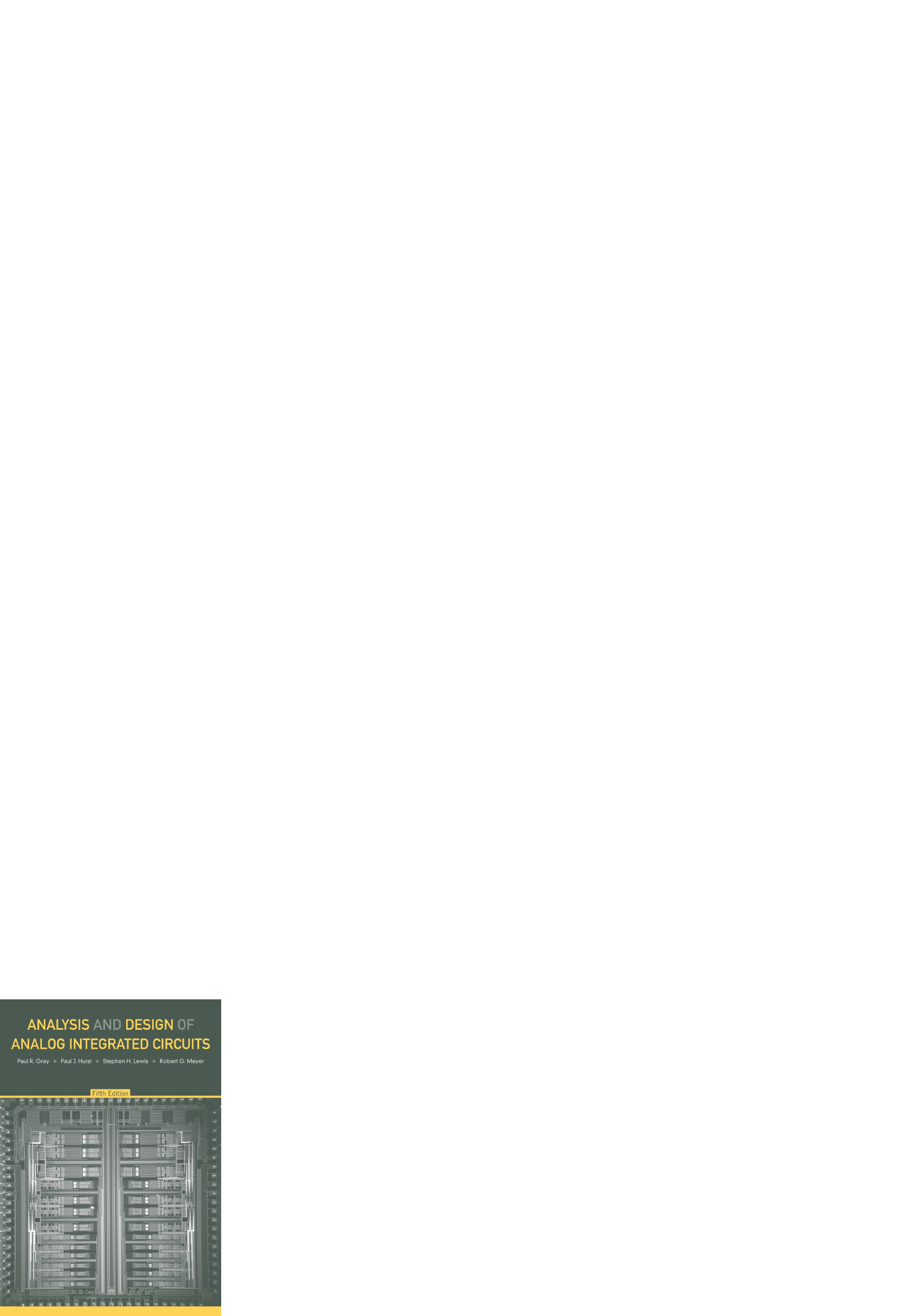

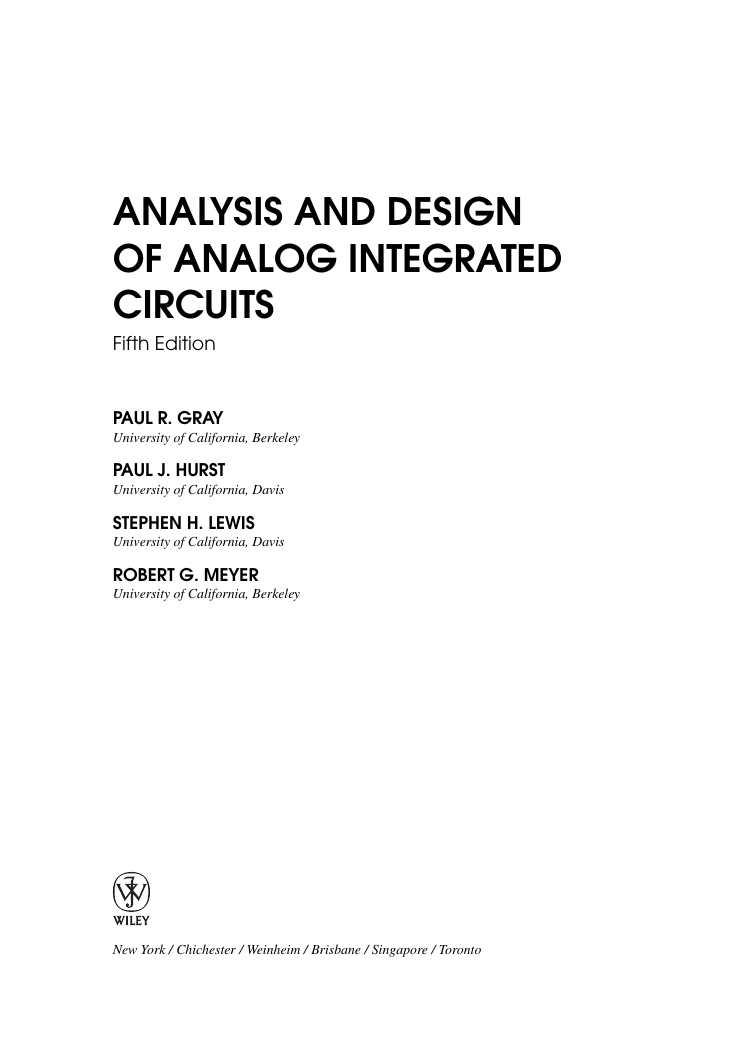
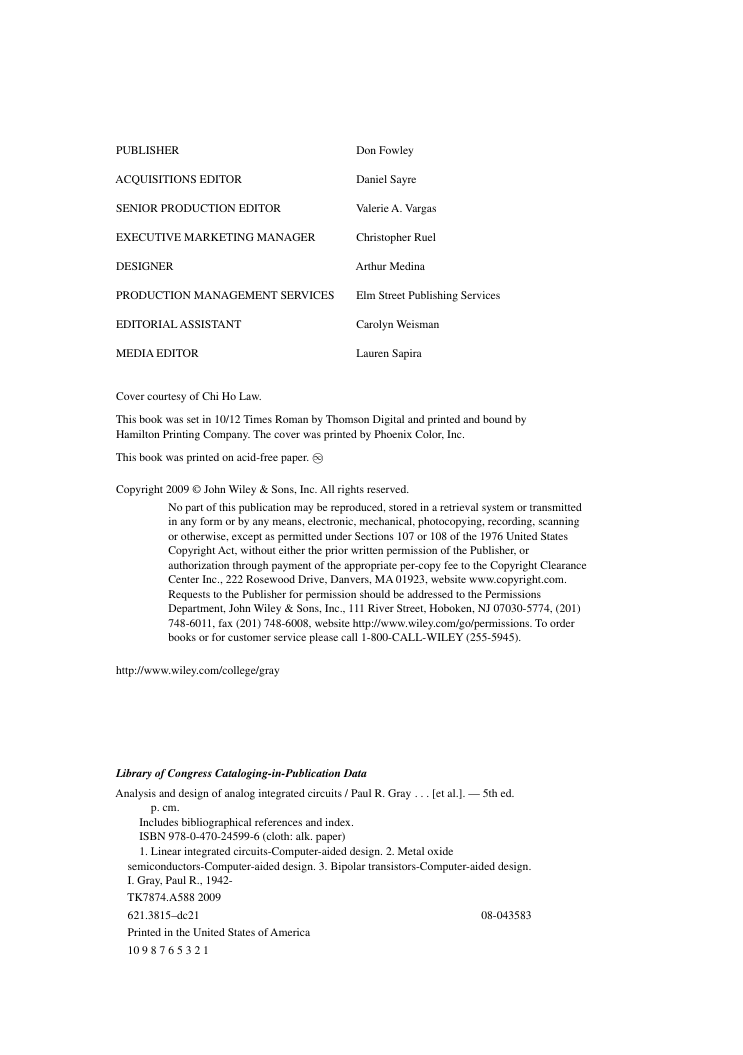
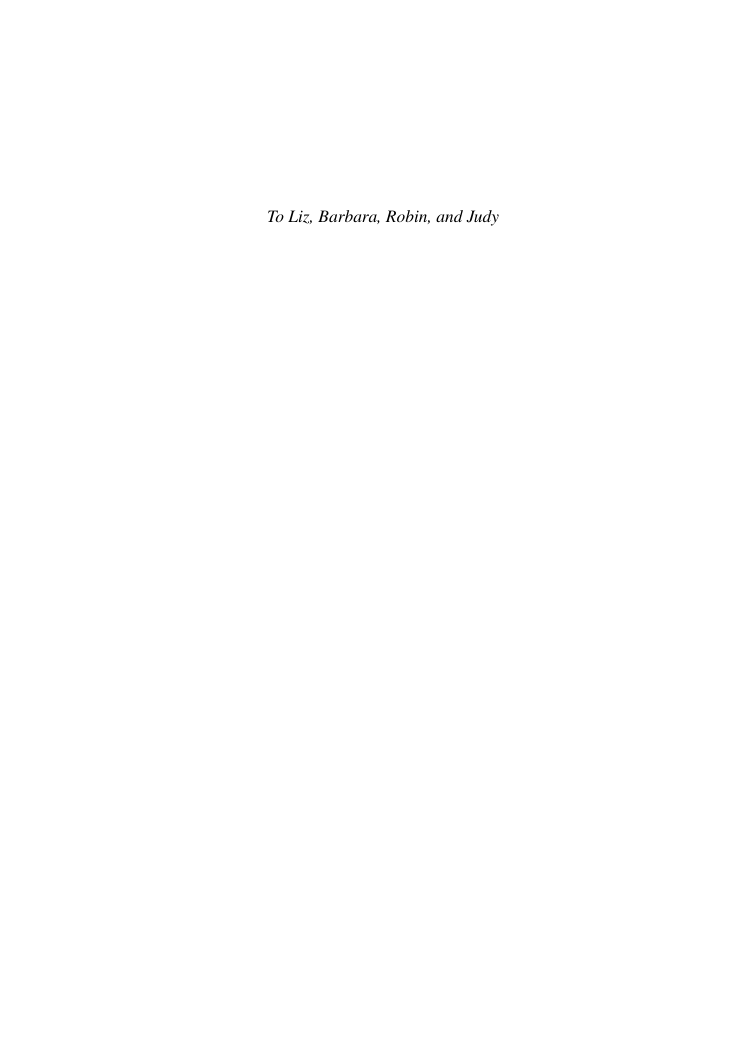
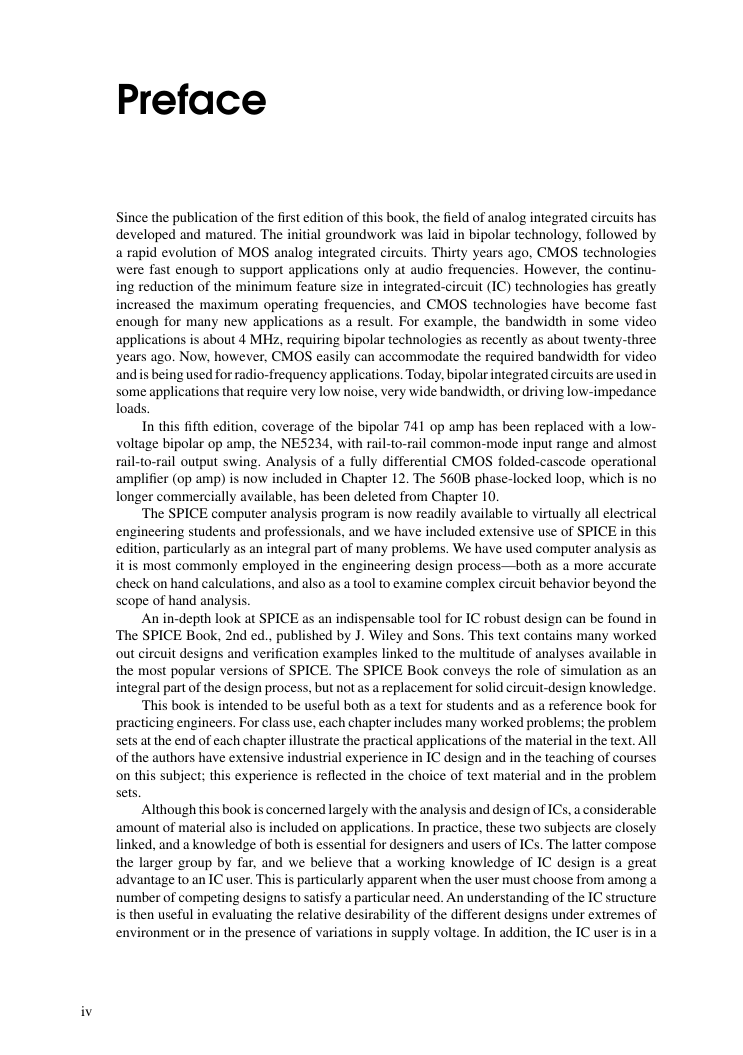
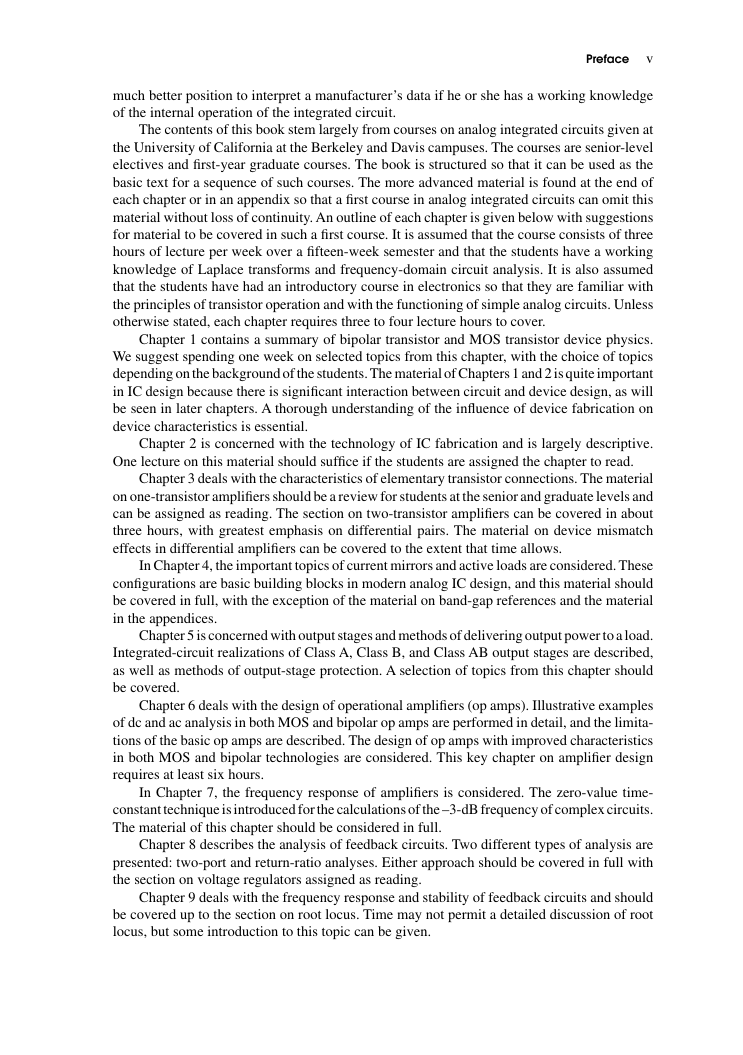
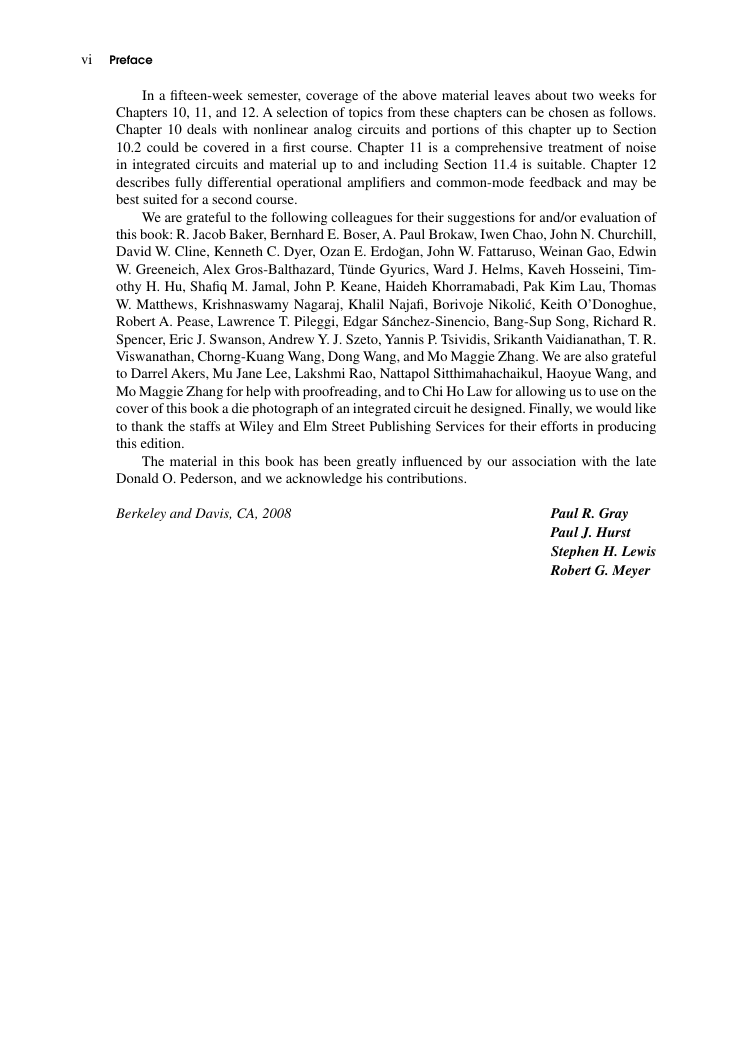








 2023年江西萍乡中考道德与法治真题及答案.doc
2023年江西萍乡中考道德与法治真题及答案.doc 2012年重庆南川中考生物真题及答案.doc
2012年重庆南川中考生物真题及答案.doc 2013年江西师范大学地理学综合及文艺理论基础考研真题.doc
2013年江西师范大学地理学综合及文艺理论基础考研真题.doc 2020年四川甘孜小升初语文真题及答案I卷.doc
2020年四川甘孜小升初语文真题及答案I卷.doc 2020年注册岩土工程师专业基础考试真题及答案.doc
2020年注册岩土工程师专业基础考试真题及答案.doc 2023-2024学年福建省厦门市九年级上学期数学月考试题及答案.doc
2023-2024学年福建省厦门市九年级上学期数学月考试题及答案.doc 2021-2022学年辽宁省沈阳市大东区九年级上学期语文期末试题及答案.doc
2021-2022学年辽宁省沈阳市大东区九年级上学期语文期末试题及答案.doc 2022-2023学年北京东城区初三第一学期物理期末试卷及答案.doc
2022-2023学年北京东城区初三第一学期物理期末试卷及答案.doc 2018上半年江西教师资格初中地理学科知识与教学能力真题及答案.doc
2018上半年江西教师资格初中地理学科知识与教学能力真题及答案.doc 2012年河北国家公务员申论考试真题及答案-省级.doc
2012年河北国家公务员申论考试真题及答案-省级.doc 2020-2021学年江苏省扬州市江都区邵樊片九年级上学期数学第一次质量检测试题及答案.doc
2020-2021学年江苏省扬州市江都区邵樊片九年级上学期数学第一次质量检测试题及答案.doc 2022下半年黑龙江教师资格证中学综合素质真题及答案.doc
2022下半年黑龙江教师资格证中学综合素质真题及答案.doc